69 Years of Height Evolution in the NBA [4,379 players analyzed]
Posted on 17 August, 2021 by Dimitrije Curcic
“You can’t teach height” - Red Auerbach
We spent 2 months analyzing 24,489 records of 4,379 NBA players during 69 NBA seasons in order to show how the game of basketball evolved through the evolution of players’ height.
Special note to Kirk Goldsberry, whose book “Sprawlball” inspired the creation of this research. This article is a height spinoff of “Sprawlball”.
69 Years of Height Evolution in the NBA [4,379 players analyzed]
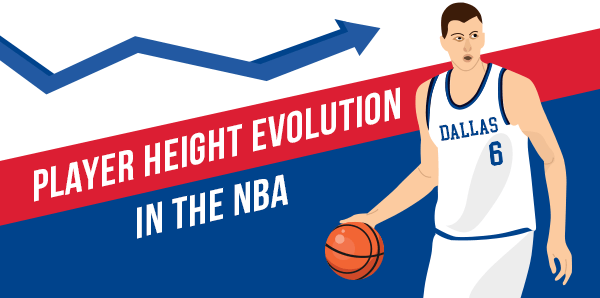
Key findings:
1. Height and weight throughout NBA history
The average NBA height is 6’6’’, which is the lowest over the past 40 years. The last decade was the first in the history of the league where NBA players got shorter than a decade before.
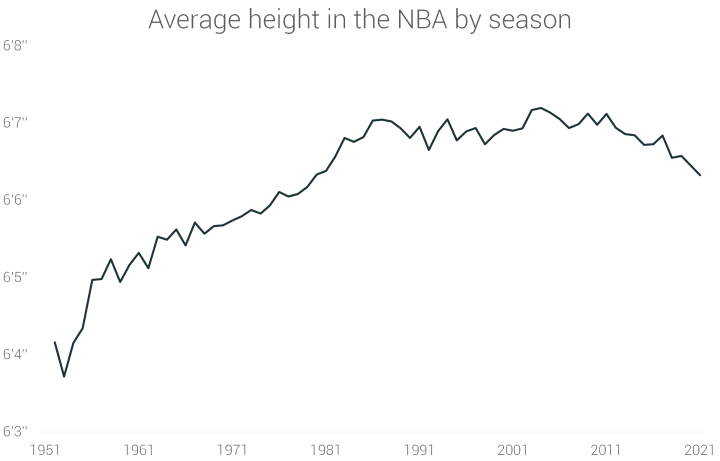
NBA point guards are 6’3’’ tall, tallest they’ve ever been.
All other positions (shooting guards, small forwards, power forwards, and centers) are the shortest since the early 80s.

The average weight in the NBA was growing since the 70s, peaked in the 2010/11 season, and has been declining ever since.
NBA players are the lightest they’ve been in the 21st century. The average weight of an NBA player is 216 lbs.
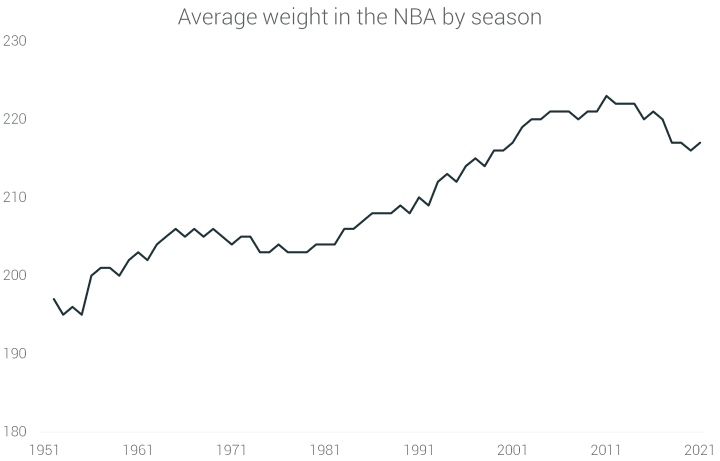
Similar to height evolution, point guards are the heaviest they’ve ever been. All other positions are getting lighter.
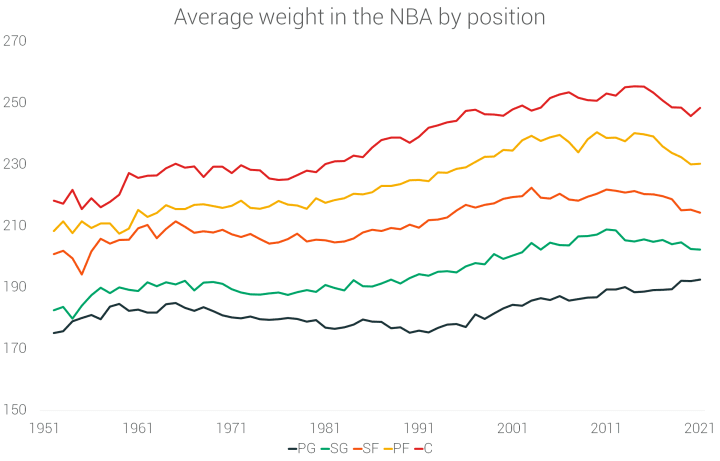
BMI of NBA players is declining over the last few seasons. The average BMI of NBA players is 24.63 and is the lowest since the 2004-05 season.
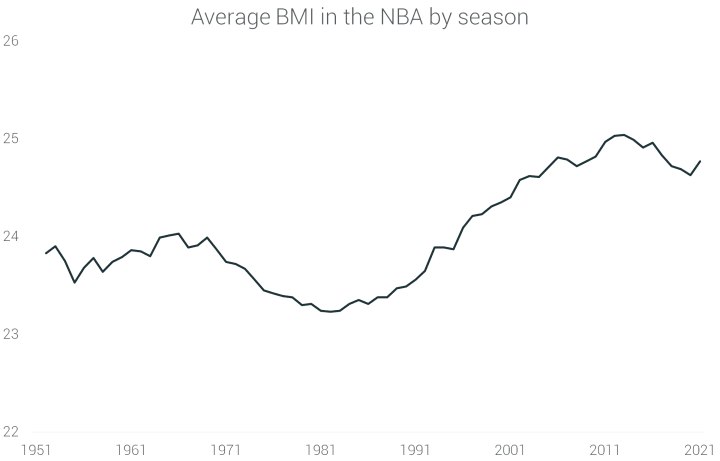
It’s understandable that NBA players, especially big-men, had to become more agile and lighter in order to adapt to the perimeter-oriented game. This is why NBA centers and power forwards are facing the biggest drop in their BMI.
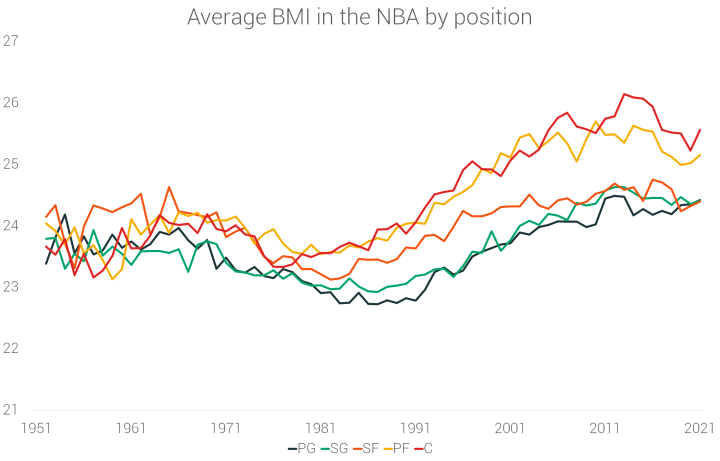
As a consequence, today we have the smallest share of “overweight” players in the NBA (BMI>25) over the past 15 years. Only 38% of NBA players are overweight according to their BMI.
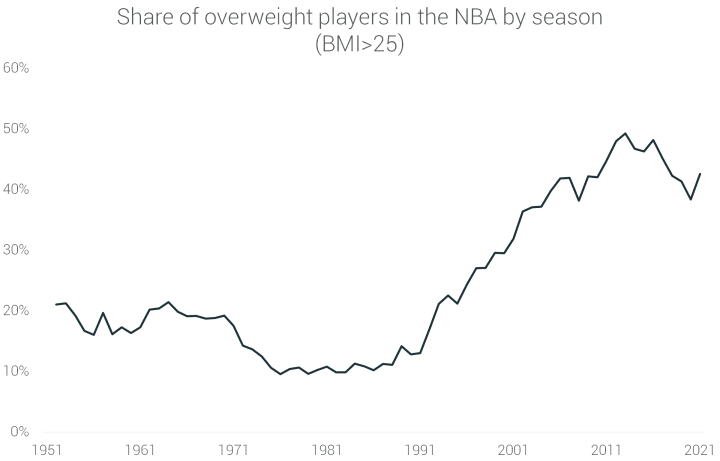
The ideal concept of the small-ball game is having 5 guys with the same physical attributes and skillset - this is positionless basketball at its peak.
So it’s not strange that 61% of the NBA players are within 6 inches, standing between 6’3’’ and 6’9’’. All other height ranges are in decline.
Also, 72% of the league is under 6’9’’.

Even the NBA’s 7-footers are taking at least 20% of their field goal attempts beyond the 3-point line. Players shorter than 6’9’’ are getting close to the 50% mark.

4. Rookie height evolution
Rookies’ data are an interesting tool to examine the league's year-to-year tendencies. The data are much more unstable and fluctuate more on a yearly basis, but they are more precise in explaining the league’s current trend.
The average height of NBA rookies is on a steady decline over the past several seasons.
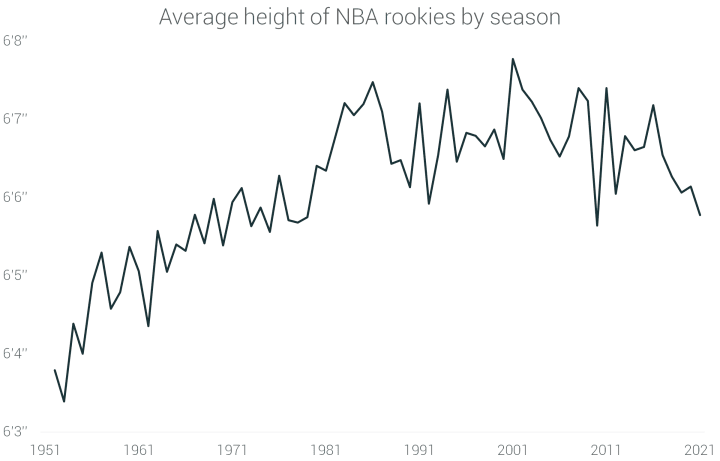
reaking down by position, international players evolve along with the league’s tendencies - big-men are getting shorter, point guards are getting taller.

International centers recorded the highest share among NBA centers in the history of the league - 46% of all NBA centers come from overseas.

Similarly, 46% of NBA players taller than 6’9’’ are international players, and foreign 7-footers are accounting for 53% of league total. This data clearly shows that international big-men are still one of the most valuable assets from NBA teams.
Posted on 17 August, 2021 by Dimitrije Curcic
“You can’t teach height” - Red Auerbach
We spent 2 months analyzing 24,489 records of 4,379 NBA players during 69 NBA seasons in order to show how the game of basketball evolved through the evolution of players’ height.
Special note to Kirk Goldsberry, whose book “Sprawlball” inspired the creation of this research. This article is a height spinoff of “Sprawlball”.
69 Years of Height Evolution in the NBA [4,379 players analyzed]

Key findings:
- The average NBA player has never been shorter over the past 39 seasons.
- Point guards are the tallest they’ve ever been in league history. All other positions are the shortest since the 80s.
- Only 38% of NBA players today are considered overweight (BMI>25), lowest over the past 15 years.
- 72% of the league is under 6’9’’ tall (most over the past 40 seasons)
- 40% of the power forwards’ FG attempts are 3-pointers (first time in NBA history). Centers are getting close to 20% (19.5).
- While declining in number, NBA’s big-men are dominating in shooting efficiency and PER, breaking all-time NBA records.
- International big-men are one of the most valuable assets for NBA teams - 53% of the NBA’s 7-footers are international players, and 46% of NBA centers are from overseas.
1. Height and weight throughout NBA history
The average NBA height is 6’6’’, which is the lowest over the past 40 years. The last decade was the first in the history of the league where NBA players got shorter than a decade before.

NBA point guards are 6’3’’ tall, tallest they’ve ever been.
All other positions (shooting guards, small forwards, power forwards, and centers) are the shortest since the early 80s.

The average weight in the NBA was growing since the 70s, peaked in the 2010/11 season, and has been declining ever since.
NBA players are the lightest they’ve been in the 21st century. The average weight of an NBA player is 216 lbs.

Similar to height evolution, point guards are the heaviest they’ve ever been. All other positions are getting lighter.

BMI of NBA players is declining over the last few seasons. The average BMI of NBA players is 24.63 and is the lowest since the 2004-05 season.

It’s understandable that NBA players, especially big-men, had to become more agile and lighter in order to adapt to the perimeter-oriented game. This is why NBA centers and power forwards are facing the biggest drop in their BMI.

As a consequence, today we have the smallest share of “overweight” players in the NBA (BMI>25) over the past 15 years. Only 38% of NBA players are overweight according to their BMI.

The ideal concept of the small-ball game is having 5 guys with the same physical attributes and skillset - this is positionless basketball at its peak.
So it’s not strange that 61% of the NBA players are within 6 inches, standing between 6’3’’ and 6’9’’. All other height ranges are in decline.
Also, 72% of the league is under 6’9’’.

Even the NBA’s 7-footers are taking at least 20% of their field goal attempts beyond the 3-point line. Players shorter than 6’9’’ are getting close to the 50% mark.

4. Rookie height evolution
Rookies’ data are an interesting tool to examine the league's year-to-year tendencies. The data are much more unstable and fluctuate more on a yearly basis, but they are more precise in explaining the league’s current trend.
The average height of NBA rookies is on a steady decline over the past several seasons.

reaking down by position, international players evolve along with the league’s tendencies - big-men are getting shorter, point guards are getting taller.

International centers recorded the highest share among NBA centers in the history of the league - 46% of all NBA centers come from overseas.

Similarly, 46% of NBA players taller than 6’9’’ are international players, and foreign 7-footers are accounting for 53% of league total. This data clearly shows that international big-men are still one of the most valuable assets from NBA teams.
 I wonder are there less 6'10"+ people being born now or are all the stiffs just not making the league anymore
I wonder are there less 6'10"+ people being born now or are all the stiffs just not making the league anymore

